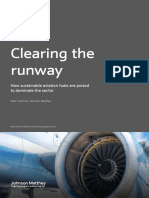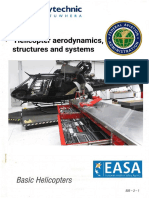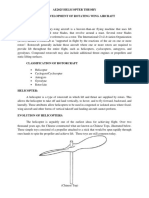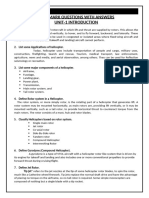0 ratings0% found this document useful (0 votes)
55 viewsHelicopter Midterm Reviewer
Helicopters use large-diameter, low disk loading rotors to generate lift for vertical flight. A main rotor provides lift and thrust while a tail rotor counters the torque from the main rotor. Helicopters require high power due to the inefficiency of vertical flight. Early development focused on creating light and reliable engines as well as strong yet aerodynamic rotor structures and flight controls. Notable early pioneers include Da Vinci, Cayley, and Cornu who made some of the first attempts at controlled rotary wing flight in the 15th-early 20th centuries.
Uploaded by
johnclientebooklibraryCopyright
© © All Rights Reserved
Available Formats
Download as PDF, TXT or read online on Scribd
0 ratings0% found this document useful (0 votes)
55 viewsHelicopter Midterm Reviewer
Helicopters use large-diameter, low disk loading rotors to generate lift for vertical flight. A main rotor provides lift and thrust while a tail rotor counters the torque from the main rotor. Helicopters require high power due to the inefficiency of vertical flight. Early development focused on creating light and reliable engines as well as strong yet aerodynamic rotor structures and flight controls. Notable early pioneers include Da Vinci, Cayley, and Cornu who made some of the first attempts at controlled rotary wing flight in the 15th-early 20th centuries.
Uploaded by
johnclientebooklibraryCopyright
© © All Rights Reserved
Available Formats
Download as PDF, TXT or read online on Scribd
You are on page 1/ 5
Helicopter Midterm Reviewer - Helicopter use large
diameter; low disk loading to
● Helicopter - aircraft that uses produce lift
rotating wings to provide lift, ● By tilting the thrust vector forward,
propulsion, and control translational velocity is achieved
● Rotor is the source of forces and
Note: moments that control its position,
- Efficient vertical flight means a attitude, and velocity.
low power loading (ratio of rotor ● Helicopters have HIGH power
power required to rotor thrust). required due to vertical flight. Large
- For a rotary wing, low power loading transmission needed for high torque
can be achieved with low disk at low speed.
loading (ratio of rotor thrust to disk
area) Helicopter Rotor
- Conservation of momentum.
Accelerates air downward to achieve
lift, due to reaction.
● Induced power loss - Kinetic
energy used on the air in the wake
of the rotor is supplied by a power
source to retain flight equilibrium
● For rotary wing in hover - induced
power loading is proportional to
square root of rotor disk loading.
Efficiency of rotor thrust
generation increases as disk ● Rotor - consists of two or more
loading decreases. identical equally spaced blades
● Induced power is inversely connected to a central hub, rotated
proportional to rotor radius. by shaft torque from the engine.
Helicopter is characterized by a ● Diameter is large for vertical flight.
large disk area. High aspect ratio for good
● For such application (rotor for aerodynamic efficiency. This results
aircraft propulsion), high disk in blades being more flexible than
loading is used due to high axial high disk loading propellers.
velocity and at a thrust equal to a ● Rotary motion produces high
fraction of the gross weight. stress, large moments at the root,
- High disk loading which is transmitted to the hub.
compromises vertical flight Centrifugal stiffening is done.
though ● Another solution is to use hinges at
- Helicopter uses low disk the blade root. Allows free motion
loading in all of VTOL, most of the blade normal to and in the
efficiently plane of the disk. Zero moment at
the hinge, so nothing is transmitted arrangement, have no lag hinges.
to the root. Similarly, a gimballed rotor has 3 or
● If there is no hinge to involve more blades attached to hub w/o
structural bending, it must be hinges, the hub is attached to the
flexible. shaft with gimbal or universal joint
arrangement.
Read separately for with hinge ● Hingeless rotor - No flap or lag
hinges. May have a feathering
● Motion of a hinged rotor blade bearing or hinge. Blade attached to
involves rigid body rotation about hub with cantilever root restraint,
each hinge. bends at root. Called a rigid rotor.
● Restoring moments are generated
by centrifugal forces acting on the Helicopter Configuration
rotating blade.
● Flap motion results from motion 2 methods to balance torque in steady flight
about the hinge located in the rotor
disk plane, causing out-of-plane ● Single main rotor and tail rotor
deflection of the blade. configuration - uses a small
● Lag motion, also known as auxiliary rotor to provide torque
lead-lag, occurs when the blade balance and yaw control. Located
moves about the vertical hinge, on the tail boom. Normally vertical.
leading to deflection within the ● Twin main rotor - Uses two contra
plane of the rotor disk. rotating rotors of equal size and
loading. No net yaw moment. No
Read separately for without hinge need for a power absorbing auxiliary
rotor.
● For a blade without hinges the
fundamental modes of out-of-plane Note: Most frequent twin rotor arrangement
and in-plane bending define the flap is the tandem helicopter configuration. Fore
and lag motion and aft placement.
● High centrifugal stiffening, root has
high bending. Helicopter Operation
● Ability to change pitch is required to
control rotor ● No vertical or translational is called
● This change in pitch alters angle of hover.
attack. Feathering motion. ● Safe operation after loss of power is
achievable by descending at a
Classification of rotor types shallow angle.
● Power off descent is called
● Articulated rotor - blades attached autorotation. Using the airflow from
to hub with flap and lag hinges descent. Establish equilibrium flight
● Teetering rotor - Two blades at minimum descent rate.
attached continuously with a ● Near the ground, the helicopter is
teetering hinge or seesaw flared. Using rotor stored kinetic
energy to remove translation and ● Launoy and Bienvenu (1784) -
vertical velocity before touchdown Spring powered model to the
● In vertical power off descent, the French academy of sciences. Had
rotor acts like a parachute of the two contra-rotating rotors of four
same diameter as the rotor disk. blades. Powered by flexed bow
● Half the descent rate achievable in ● Sir George Cayley (1790s) - Models
forward flight. with plastic elements
● Autogiro - Rotary wing that uses
autorotation as normal state. No Attempts to use steam engine
power or shaft torque is supplied to
the rotor unlike a helicopter. Power ● W.H. Philips (1842) - 10 kg steam
and propulsive force to sustain model
forward flight is provided by a ● Viscomte Gustave de Ponton
propeller or another propulsion d'Amecourt (1863) - small team
device. Only provides lift. driven model, invented the word
● Rotor has a good lift to drag ratio, “helicopter”
although not as good as a fixed ● Alphonse Penaud (1870) -
wing. Provides lift/control at much experimented with models
lower speeds. ● Enrico Forlanini (1878) - 3.5 steam
model
History and Development of Helicopters ● Thomas Edison (1880s) -
Experimented with models.
3 major challenges Recognized lack of adequate
engine. Need weight to power ratio
- Light and reliable engine, first using below 1 to 2 kg/hp.
the reciprocating engine, then
adopted the turboshaft engine. Attempts to use reciprocating gasoline
- Light and strong structure for the engine
rotor, hub, and blades while
maintaining aerodynamic efficiency ● Renard (1904) - helicopter with 2
- Means of controlling the helicopter, side by side rotor using 2 cylinder
including balancing the rotor torque engine. Introduced flapping hinge.
● Breguet-Richet - Gyroplane No. 1
Timeline had 4 rotors with 4 biplane blades.
Made a tethered flight with 1
● Chinese flying top (400 BC) - Toy passenger for 1 minute at 1 meter.
spun by hands and released ● Paul Cornu (1907) - First flight with
● Leonardo Da Vinci’s work (late 15th pilot. 2 contra-rotating rotors.
century) - Sketches of machine for Controlled by vanes in slipstream.
vertical flight using screw-type 0.3m for 20 seconds.
propeller - Problems of stability and
● Mikhail V Lomonosov (1754) - mechanical
Spring powered model to russian
academy of sciences
● Emile and Henry Berliner (1909) - 2 control using swash plate. Used
engine coaxial helicopter. teetering rotor
Untethered. ● Corradino d'Ascanio (1930) - Two
● Igor Sikorsky (1910) - 2 coaxial three coaxial rotors. Had flap and
bladed rotors. Lifts 180 kg. free-feathering hinges. Control by
● Boris N. Yuriev (1912) - 2 bladed servo tabs.
main rotor with anti torque tail ● M.B. Blecker - Four wing-like
rotor. blades.
● Petroczy and Von Karman (1916) - ● The Central Aero-Hydrodynamic
Tethered observation helicopter. 50 Institute of the Soviet Union (1931) -
meters with payload. Series of single rotor helicopters
under Yuriev
Better engines after WWI
Development of autogiro - first practical
● George de Bothezat (1922) - use of direct-lift rotary wing. Term coined by
Helicopter with four six-bladed rotors Juan de la Cierva
at the end of intersecting beams. - Windmilling rotor, capable of very
Good control, utilizing differential slow flight.
collective. First rotorcraft ordered
by US Army ● Juan de la Cierva (1919) - airplane
● Etienne Oemichen (1924) - Machine crashed due to a stall near the
with four two bladed rotors, 7.6 ground. Rearward tilt of rotor for
meters in diameter. 120 HP Le good lift to drag ratio.
Rhone Engine ● Cierva (1922) - C-3 Autogiro with 5
● Marquis Raul Pateras Pescara blade rigid rotor. Tendency to fall
(1924) - Two coaxial rotors with four over sideways. Flexible and
biplane blades. Warps blades to articulated rotor blades.
change pitch angle, first to - Flap hinge eliminated the
demonstrate effective pitch cyclic rolling moment
control. - In 1923, C-4 autogiro was
- Cyclic Pitch: sinusoidal, once built. Controlled with
per revolution change made aerodynamic control
in blade pitch to tilt surfaces
● Emile and Henry Berliner ● 1924 - C6 Autogiro with flapping
(1920-1925) - Two rotors positioned rotor blades. Avro 504K aircraft
on tips in side by side configuration/ fuselage. Demonstrated in 1925
Used rigid wooden propellers. ● 1925 - Cierva founded his Cierva
● Louis Brennan - Rotor turned by Autogiro Company, producing 500
propellers, eliminates torque autogiros.
problem. Too complex. Warps
blades with control tabs. A crash in 1927 led to development of lag
● A.G. von Baumhauer (1924-1929) - hinges due to flapping loads.
a single main rotor and a vertical tail
rotor for torque balance. Cyclic pitch
● 1932 - Cierva added rotor control to ● 1942 - R-4 VS 316, derivative of VS
replace control surfaces for lateral 300.
and longitudinal control. Not
effective at low speeds. ● Lawrence Bell (1943) - two bladed
● Raoul Hafner (1935) - Spider teetering main rotor and tail rotor.
control mechanism for cyclic pitch Uses a gyro stabilizer bar
control developed by Arthur Young.
● E. Burke Wilford (1930s) - ● 1946 - Bell Model 47
hingeless rotor autogiro that also ● Frank N Piasecki eventually became
used cyclic control Boeing Vertol Company
● Louis Breguet and Rene Dorand ● Louis Breguet (1946) - Built the G-11
(1935) - Coaxial two bladed rotors. E. 2 coaxial contra-rotating rotor.
Had an articulated hub (flap and lag Fully articulated hub with flap and
hinges). Cyclic control for pitch and lag damper
roll, differential torque for directional. ● Stanley Hiller (1946-1948) -
● E.H. Henrich Focke (1936) - Three Developed control rotor, gyro
bladed rotors mounted on trusses. stabilizer bar. Model 360 in 1947.
Articulated hub and tapered blades. ● Charles Kaman (1946-1948) -
● Anton Flettner (1938-1940) - Kaman Aircraft in the US. Developed
Synchropter design. Inter meshed servo-tab control method of rotor
side by side configuration. pitch control. Twist blade.
● C.G. Pullin (1938) - Side by side ● Mikhail Mil' (1949) - Series of
configuration W-S, SO Hp. helicopters with single main and tail
● Ivan P. Bratukhin (1939-1940) - rotor.
Omega I helicopter. ● Nikolai I Kamov (1952) - Ka-15
Helicopter
Considerable effort in rotary wing ● Alexander Yakolev (1952) - Yak-24
development during World War 2 by helicopter.
Germany. ● Kaman Aircraft Company (1951) -
First helicopter with turbine power,
● 1941 - Focke Achgelis FA 223. First single turbo shaft engine in K-225
successful helicopter is FA 61 helicopter.
● Igor Sikorsky (1939-1941) - ● 1954 - First twin-engine turbine
Returned to helicopter development powered helicopter. HTK 1
in 1938, Russia and US Synchropter with two boeing
● 1941 - Sikorsky built VS 300. engines.
Auxiliary rotors reduced to two. First
practical helicopter Turboshaft has become standard for
● Sikorsky’s eighteenth with single helicopters.
main rotor and tail rotor configuration
has become the most common
helicopter type.
● Vibration in two bladed main rotors.
You might also like
- JM Biofuels - Clearing The Runway (2023)No ratings yetJM Biofuels - Clearing The Runway (2023)6 pages
- Helicopter Operation and Systems - Lec 8No ratings yetHelicopter Operation and Systems - Lec 850 pages
- Helicopter Aerodynamics, Structures and Systems100% (11)Helicopter Aerodynamics, Structures and Systems414 pages
- July 9, 1968 T M. A. Cardoso 3,391,746: Helicopter Control System Filed May 15, 1967 3 Sheets-Sheet 1No ratings yetJuly 9, 1968 T M. A. Cardoso 3,391,746: Helicopter Control System Filed May 15, 1967 3 Sheets-Sheet 17 pages
- Write Up For Main Rotor System Edited Final100% (1)Write Up For Main Rotor System Edited Final13 pages
- The Compound Helicopter Configuration and TheNo ratings yetThe Compound Helicopter Configuration and The7 pages
- A Brief Introduction To Helicopters: Penn TateNo ratings yetA Brief Introduction To Helicopters: Penn Tate28 pages
- Development of a rotor blade aeromechanic modelNo ratings yetDevelopment of a rotor blade aeromechanic model91 pages
- General Helicopter & Airframe Theory-By Lijalem G/Hiwot-2006No ratings yetGeneral Helicopter & Airframe Theory-By Lijalem G/Hiwot-200645 pages
- Helicopter Assignment Helicopter Systems: Main Rotor SystemNo ratings yetHelicopter Assignment Helicopter Systems: Main Rotor System10 pages
- Farm Machinery - Tractors - A Collection of Articles on the Operation, Mechanics and Maintenance of TractorsFrom EverandFarm Machinery - Tractors - A Collection of Articles on the Operation, Mechanics and Maintenance of TractorsNo ratings yet
- The Instant Handbook of Boat Handling, Navigation, and Seamanship: A Quick-Reference Guide for Sail and PowerFrom EverandThe Instant Handbook of Boat Handling, Navigation, and Seamanship: A Quick-Reference Guide for Sail and Power5/5 (1)
- Wood Turning - The Lathe and Its Accessories, Tools, Turning Between Centres Face-Plate Work, Boring, PolishingFrom EverandWood Turning - The Lathe and Its Accessories, Tools, Turning Between Centres Face-Plate Work, Boring, PolishingNo ratings yet
- D.Y. Patil Technical Campus, Talsande Faculty of Engineering & Faculty of Management (Polytechnic)No ratings yetD.Y. Patil Technical Campus, Talsande Faculty of Engineering & Faculty of Management (Polytechnic)11 pages
- Atc Training and Emergency Handling: "Never Stop Learning, For When We Stop Learning, We Stop Growing"No ratings yetAtc Training and Emergency Handling: "Never Stop Learning, For When We Stop Learning, We Stop Growing"2 pages
- (With Happyeasygo) : E-Ticket Order ID 591653108208238715No ratings yet(With Happyeasygo) : E-Ticket Order ID 5916531082082387152 pages
- 3049 - Airbus Helicopters - Deutschland - MBB - BK-117No ratings yet3049 - Airbus Helicopters - Deutschland - MBB - BK-11715 pages
- AirAsia Booking Book Low Fares Online PDFNo ratings yetAirAsia Booking Book Low Fares Online PDF2 pages
- Where can buy The First Blitz Bombing London in the First World War 1st Edition Ian Castle ebook with cheap price100% (9)Where can buy The First Blitz Bombing London in the First World War 1st Edition Ian Castle ebook with cheap price60 pages
- Lumbia Airfield Type: Civil Aviation Authority of The Philippines (No ratings yetLumbia Airfield Type: Civil Aviation Authority of The Philippines (2 pages
- Ground Traffic Phraseology - CompressedNo ratings yetGround Traffic Phraseology - Compressed40 pages
- PART 10 Commercial Air Transport by Foreign Air Carriers Within Republic of The PhilippinesNo ratings yetPART 10 Commercial Air Transport by Foreign Air Carriers Within Republic of The Philippines32 pages
- July 9, 1968 T M. A. Cardoso 3,391,746: Helicopter Control System Filed May 15, 1967 3 Sheets-Sheet 1July 9, 1968 T M. A. Cardoso 3,391,746: Helicopter Control System Filed May 15, 1967 3 Sheets-Sheet 1
- General Helicopter & Airframe Theory-By Lijalem G/Hiwot-2006General Helicopter & Airframe Theory-By Lijalem G/Hiwot-2006
- Helicopter Assignment Helicopter Systems: Main Rotor SystemHelicopter Assignment Helicopter Systems: Main Rotor System
- Farm Machinery - Tractors - A Collection of Articles on the Operation, Mechanics and Maintenance of TractorsFrom EverandFarm Machinery - Tractors - A Collection of Articles on the Operation, Mechanics and Maintenance of Tractors
- The Instant Handbook of Boat Handling, Navigation, and Seamanship: A Quick-Reference Guide for Sail and PowerFrom EverandThe Instant Handbook of Boat Handling, Navigation, and Seamanship: A Quick-Reference Guide for Sail and Power
- Wood Turning - The Lathe and Its Accessories, Tools, Turning Between Centres Face-Plate Work, Boring, PolishingFrom EverandWood Turning - The Lathe and Its Accessories, Tools, Turning Between Centres Face-Plate Work, Boring, Polishing
- D.Y. Patil Technical Campus, Talsande Faculty of Engineering & Faculty of Management (Polytechnic)D.Y. Patil Technical Campus, Talsande Faculty of Engineering & Faculty of Management (Polytechnic)
- Atc Training and Emergency Handling: "Never Stop Learning, For When We Stop Learning, We Stop Growing"Atc Training and Emergency Handling: "Never Stop Learning, For When We Stop Learning, We Stop Growing"
- (With Happyeasygo) : E-Ticket Order ID 591653108208238715(With Happyeasygo) : E-Ticket Order ID 591653108208238715
- 3049 - Airbus Helicopters - Deutschland - MBB - BK-1173049 - Airbus Helicopters - Deutschland - MBB - BK-117
- Where can buy The First Blitz Bombing London in the First World War 1st Edition Ian Castle ebook with cheap priceWhere can buy The First Blitz Bombing London in the First World War 1st Edition Ian Castle ebook with cheap price
- Lumbia Airfield Type: Civil Aviation Authority of The Philippines (Lumbia Airfield Type: Civil Aviation Authority of The Philippines (
- PART 10 Commercial Air Transport by Foreign Air Carriers Within Republic of The PhilippinesPART 10 Commercial Air Transport by Foreign Air Carriers Within Republic of The Philippines

























































































